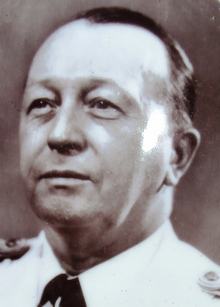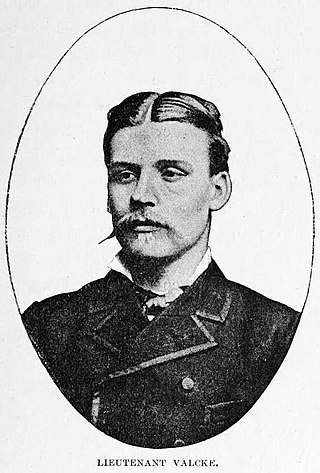
Johannes Hubertus "Hubert" Biermans (31 December 1864, Herkenbosch [1] - 12 February 1953, Monaco [2] ) was a Dutch and Canadian businessman.

Johannes Hubertus "Hubert" Biermans (31 December 1864, Herkenbosch [1] - 12 February 1953, Monaco [2] ) was a Dutch and Canadian businessman.
Jean Hubert Biermans was the son of Frans Biermans and Maria Joanna Hubertina Ruyten. [3] His father was a baker in Herkenbosch, a village in the province of Limburg, in the Netherlands. In 1877, at the age of 12, Hubert began working for a Belgian railroad construction company. From then until 1888, he worked at various railroad construction sites in Belgium, Luxembourg, Italy, France and, from 1886 to 1888, in Algeria, where he was given the direction of the works. [4]
In 1889, in Brussels, he entered at the service of the Compagnie de chemin de fer du Congo, of Belgian businessman Albert Thys. From 1890 to 1898, in Congo, Biermans worked on the construction of the Matadi-Léopoldville Railway, linking the port of Matadi to the Stanley Pool and to Léopoldville. [5] At first, he was chief of an advanced survey team. He was later promoted to director of the superstructure team.
Back in Belgium, he was commissioned by the Banque d'Outremer for exploring railroad projects in different countries, from 1898 to 1900.
On November 9, 1900, Biermans arrived in Shawinigan, Quebec, Canada, to evaluate the advancement of the construction of a pulp and paper plant. [6] He became director of the Belgian-owned Belgo Canadian Pulp & Paper Company ("the Belgo"). [7] On December 12, 1907, he married Berthe Lapôtre, in Middelkerke, Belgium. [8] He obtained Canadian citizenship. He ran for the Legislative Assembly of Quebec in the 1919 Quebec general election as an "independent liberal" candidate, in the district of Saint-Maurice, but was defeated by the official Liberal incumbent. [9] That was his only attempt at politics. He retired as director of the Belgo in 1926.
Having accumulated a considerable fortune, Biermans settled in Europe, living in his houses in Paris, Monaco, Salneuve and Brussels, and managing his investments in many companies. Leaving Europe at the beginning of the Second World War, he lived near Montréal during the War, after which he returned to Europe. He made donations to several institutions and left instructions for his fiduciaries that the rest of his fortune be donated after his death. He died in 1953.
His donations brought him many honours. He was made Commander of the Légion d'honneur (France), Commander of the Order of the Crown (Belgium), Grand Officer of the Order of Leopold (Belgium), Grand Officer of the Order of Leopold II (Belgium), Commander of the Royal Order of the Lion (Congo), Grand Officer of the Order of the Oak Crown (Luxembourg). Streets are named after him in Shawinigan and in Herkenbosch. Buildings are named after him in Paris, Québec City, Herkenbosch and Montréal.

The Belgian Congo was a Belgian colony in Central Africa from 1908 until independence in 1960 and became the Republic of the Congo (Léopoldville). The former colony adopted its present name, the Democratic Republic of the Congo (DRC), in 1964.

Shawinigan is a city located on the Saint-Maurice River in the Mauricie area in Quebec, Canada. It had a population of 49,620 as of the 2021 Canadian census.

Boma is a port town on the Congo River, some 100 kilometres (62 mi) upstream from the Atlantic Ocean, in the Kongo Central Province of the Democratic Republic of the Congo (DRC), adjacent to the border with Angola. It had an estimated population of 162,521 in 2012.

Albert Thys was a Belgian businessman who was active in the Congo Free State. He gave his name of Thysville to the station of Sona Qongo, currently Mbanza-Ngungu in Bas-Congo.

The Railway Company of the Congo was a narrow gauge railway company in the Congo, which built and operated the Matadi–Kinshasa Railway initially with a gauge of 750 mm.

Émile Robert Alphonse Hippolyte Janssens was a Belgian military officer and colonial official, best known for his command of the Force Publique at the start of the Congo Crisis. He described himself as the "Little Maniac" and was a staunch disciplinarian, but his refusal to see Congolese independence as marking a change in the nature of his command has been cited as the immediate cause of the mutiny by the Force Publique in July 1960 that plunged Congo-Léopoldville into chaos and anarchy.
Maurice Mpolo was a Congolese politician who served as Minister of Youth and Sports of the Republic of the Congo in 1960. He briefly led the Congolese army that July. He was executed alongside Prime Minister Patrice Lumumba in Katanga in 1961.

The Banque du Congo Belge was a Belgian colonial bank that mainly operated in the Belgian Congo from 1909 to 1960. Following Congolese independence, it kept operating as the Banque du Congo from 1960 to 1971, the Banque Commerciale Zaïroise from 1971 to 1997, and the Banque Commerciale Du Congo (BCDC) from 1997 to 2020, when it was acquired by Kenya-based Equity Group Holdings and became part of Equity Banque Commerciale du Congo.
On 13 January 1959, King Baudouin addressed the nation by radio and declared that Belgium would work towards the full independence of the Belgian Congo.

On 5 July 1960, soldiers of the garrisons of Léopoldville and Thysville of the Force Publique, the army of the newly independent Republic of the Congo mutinied against their white officers. The revolt quickly spread throughout the Bas-Congo and engulfed the country in disorder, beginning the Congo Crisis.

Pierre Nauwelaert was a Belgian colonial administrator. He was interim governor of Équateur Province from 1950 to 1951, and was governor of Léopoldville Province from 1953 to 1955.

The Districts of the Belgian Congo were the primary administrative divisions when Belgium annexed the Congo Free State in 1908, each administered by a district commissioner. In 1914 they were distributed among four large provinces, with some boundary changes. In 1933 the provinces were restructured into six, again with boundary changes. The number of districts fluctuated between 12 and 26 through splits and consolidations, first rising, then falling, then rising again.

Bas-Congo was a district of the Belgian Congo and the Democratic Republic of the Congo. It went through various significant changes in extent. It roughly corresponds to the present province of Kongo Central.

The Districts of the Congo Free State were the primary administrative divisions of the Congo Free State from 1885 to 1908. There were various boundary changes in the period before the Congo Free State was annexed by Belgium to become the Belgian Congo.

Louis Pierre Alphonse Valcke was a Belgian viceroy and soldier.

The Compagnie du Congo pour le Commerce et l’Industrie (CCCI) was a major conglomerate active in the Congo Free State, Belgian Congo and later the Democratic Republic of the Congo where its subsidiary companies engaged in a wide range of activities in the Congo between 1887 and 1971. These included railway and river transport, mining, agriculture, banking, trading and so on. It was the largest commercial enterprise in the Congo for many years. It went through various mergers in the years that followed before its successor Finoutremer was liquidated in 2000.
Odon Jadot was a Belgian railway engineer and administrator. He was responsible for building more than 1,650 kilometres (1,030 mi) of railroad in the Belgian Congo. The lines helped carry copper mined in the Katanga Province to the sea via the ports of Matadi in the Congo, Dilolo in Angola and Beira in Mozambique. They also supported troop movements during World War I (1914–1918) and World War II (1939–1045).

Lambert Paul Jadot was a Belgian civil engineer and executive who was active in railways, mining and other enterprises in China, Canada and the Belgian Congo during the colonial era.

The equestrian statue of Leopold II is a bronze equestrian statue erected in Brussels, Belgium, in memory of King Leopold II, second King of the Belgians. It was created by the sculptor Thomas Vinçotte in 1914, but it was not finalised until 1926 by the architect François Malfait, when it was inaugurated in honour of the king.

The Gare de l'Est, also known as Kinshasa Est or Kinshasa Central Station, is a central railway station situated in the Gombe commune of Kinshasa, Democratic Republic of the Congo (DRC). Positioned along the Matadi–Kinshasa Railway line, it functions as a pivotal transshipment point connecting the railway and the river. Managed by the Société Commerciale des Transports et des Ports (SCTP), the station stands near Ngobila Beach at the Port of Kinshasa, fostering maritime links with Brazzaville, and is conveniently located close to SCTP buildings and the Ministry of Transport and Channels of Communication.